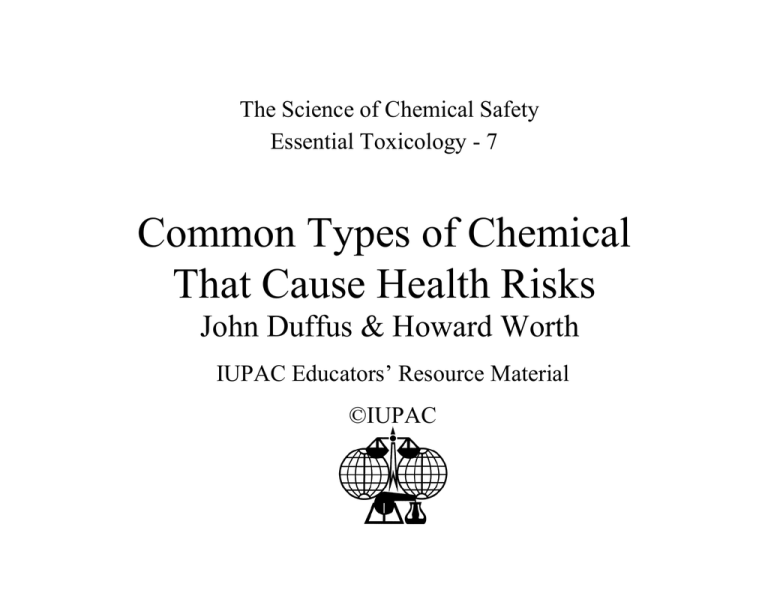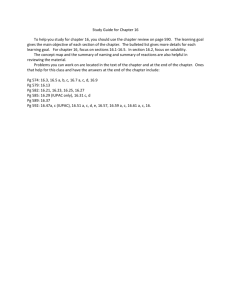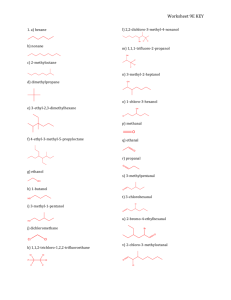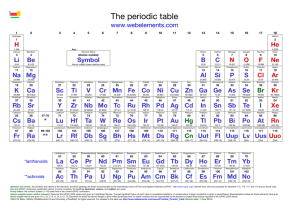Common Types of Chemical That Cause Health Risks
advertisement

The Science of Chemical Safety Essential Toxicology - 7 Common Types of Chemical That Cause Health Risks John Duffus & Howard Worth IUPAC Educators’ Resource Material ©IUPAC Dusts and Fumes • All particles may be harmful: the effect depends on size of particles and amount and nature of substance: particles less than 10 µm (PM10 fraction) can be breathed deep in the lungs and those less than 2.5 µm (PM2.5 fraction) may be particularly dangerous • Dusts containing crystalline silica or asbestos may cause incurable lung damage leading to cancer, especially in smokers: metal fumes may cause “metal fume fever” Duffus & Worth, ©IUPAC 2 Gases - Phosgene • Gases such as sulfur oxides, nitrogen oxides, chlorine and ammonia are corrosive and irritating to the lungs and nose • Phosgene is formed when solvents containing chlorine, such as 1,1,1-trichloroethane, trichloroethylene, or carbon tetrachloride come into contact with hot surfaces or flames – Phosgene can kill before its smell is detectable: phosgene is produced in cigarettes in the presence of chlorinated solvents in the surrounding atmosphere Duffus & Worth, ©IUPAC 3 Carbon Monoxide • Carbon monoxide is an odourless colourless gas formed by incomplete burning of carbon compounds: Carbon monoxide gradually blocks oxygen supply to the nervous system, making your brain function less effectively before it causes death; it reacts with haemoglobin stopping it carrying oxygen in the blood Duffus & Worth, ©IUPAC 4 Hydrogen Cyanide • Hydrogen cyanide gas can pass through the skin as well as the lungs and kills by depriving your brain and heart of oxygen; it reacts with the final electron carrier of the cytochrome system to block cell respiration Duffus & Worth, ©IUPAC 5 Solvents - 1 • Apart from water, most solvents are liquid organic chemicals and many evaporate rapidly at room temperature • Organic solvents are often flammable: organic solvent vapours may be inhaled or the liquid absorbed through the skin. – Many organic solvents cause dizziness, headache, reduced brain activity, and tiredness. They may irritate the skin, eyes, nose and lungs. They may damage the liver, kidneys, bone marrow and nervous system Duffus & Worth, ©IUPAC 6 Solvents - 2 • Benzene, carbon tetrachloride and carbon disulfide are particularly dangerous – Benzene can cause leukaemia, a cancer of the white blood cells – Carbon tetrachloride can cause severe liver damage. – Carbon disulfide affects the brain and nervous system causing character change and unpredictable behaviour Duffus & Worth, ©IUPAC 7 Metals - 1 • Metals can enter the body as dust, fumes or through the skin; alkyl derivatives may be particularly dangerous because their fat solubility enables them to enter the body readily, for example methylmercury • Cadmium poisons the liver and the kidney: it was associated with itai itai disease in Japan after contamination of rice fields Duffus & Worth, ©IUPAC 8 Metals - 2 • Chromium compounds cause dermatitis and some chromates may cause lung cancer • Lead causes anaemia and harms brain and nerve function. • Mercury, breathed in as elemental vapour, or absorbed as methylmercury from the skin or gut, damages the nervous system and kills at quite low exposures. • Nickel metal causes dermatitis: some nickel compounds may cause lung and nose cancer Duffus & Worth, ©IUPAC 9 Arsenic • Arsenic is a semi-metal (metalloid) which may be present with metals in the form of arsenides, arsenites, and arsenates; chronic arsenic poisoning can start with irritation of the lungs, the eyes or the skin and lead to damage to the nervous system and to cancer, especially of the skin • It should be noted that not all forms of arsenic are highly poisonous – Arsenobetaine found in large quantity in shellfish is so rapidly excreted by people that it has never been associated with poisoning Duffus & Worth, ©IUPAC 10 Acids and Bases - 1 • Strong acids and bases are corrosive to human tissue: stirring may create mists which can be breathed in and attack the nose and lungs • Mixing strong acids and bases or adding water to them produces heat which can cause them to splash up: when diluting, strong acids should always be added to water; water should never be added to strong acids • Some acids are explosive in contact with organic material like sawdust Duffus & Worth, ©IUPAC 11 Acids and Bases - 2 • Reaction of acid with pieces of metal can release flammable hydrogen gas as well as acid mist. • Phosphoric acid in contact with hot surfaces releases very poisonous phosphorus oxide gases. • Strong bases like ammonium, sodium and potassium hydroxides are corrosive to human tissue: some time may pass before the person affected feels the damage. – Bases penetrate the skin and cause deep sores: even dilute base solutions cause tissue irritation Duffus & Worth, ©IUPAC 12 Pesticides - 1 • Pesticides are used to destroy pests of all kinds including weeds (herbicides): many, including herbicides such as paraquat, are poisonous to people; some have a very low toxicity to people but should still be used with care • The World Health Organization (WHO) has classified them into groups according to the danger they might pose to people and the environment. • The WHO classification is as follows on the next slide Duffus & Worth, ©IUPAC 13 Pesticides - 2 • EXTREMELY HAZARDOUS – Examples: Aldicarb, Chlormephos, Parathion • HIGHLY HAZARDOUS – Examples: Aldrin, Antu, Warfarin • MODERATELY HAZARDOUS – Examples: Cyanophenphos, Cypermethrin, Sulfallate • SLIGHTLY HAZARDOUS – Examples: Allethrin, Kelthane, Malathion Duffus & Worth, ©IUPAC 14 Self Assessment - 7.1 True or false? • All dusts can cause lung damage - see slide 2 • Chlorinated solvents can give rise to phosgene if exposed to flames - see slide 3 • Gases can cause harm by corrosive action or by depriving the body of oxygen - see slides 3 and 4 • Organic solvents are not readily absorbed by the body - see slide 6 Duffus & Worth, ©IUPAC 15 Self Assessment - 7.2 True or false? • Metals can cause anaemia, dermatitis, or cancer - see slide 9 • All arsenic compounds are poisonous - see slide 10 • Acids can generate heat and toxic gases in chemical reactions - see slides 11 and 12 • Most pesticides are not toxic to people - see slides 13 Duffus & Worth, ©IUPAC 16 Self Assessment - 7.1 Checklist • All dusts can cause lung damage - True • Chlorinated solvents can give rise to phosgene if exposed to flames - True • Gases can cause harm by corrosive action or by depriving the body of oxygen - True • Organic solvents are not readily absorbed by the body - False Duffus & Worth, ©IUPAC 17 Self Assessment - 7.2 Checklist • Metals can cause anaemia, dermatitis, or cancer - True • All arsenic compounds are poisonous - False • Acids can generate heat and toxic gases in chemical reactions - True • Most pesticides are not toxic to people - False Duffus & Worth, ©IUPAC 18






